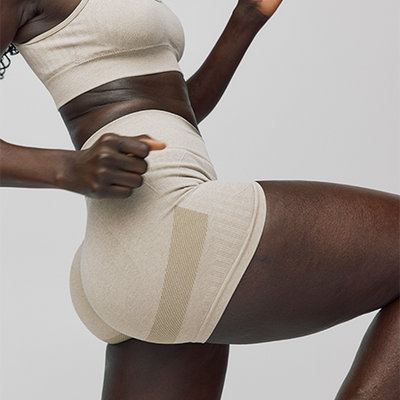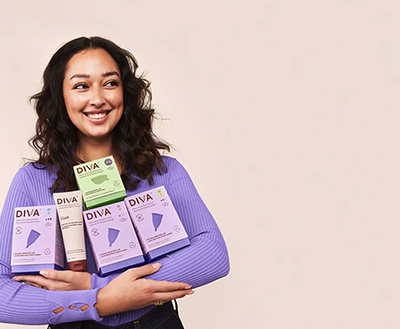

“Cycle syncing,” a term coined by In the Flo author Alisa Vitti, is the practice of tracking hormonal shifts and honoring the different physical and mental needs of each phase of your menstrual cycle.
There are four distinct phases of your cycle starting with the menstrual phase, followed by the follicular, then ovulatory, and luteal phases. They correlate with the rise and fall of our sex hormones, estrogen and progesterone.
The benefits of cycle syncing include increased physical performance, weight loss, reductions in stress, improvements in hormone production and regulation, and overall feelings of wellbeing. The idea being that listening to your body and responding to what it is telling you about energy, muscular endurance and your dietary needs, you can increase overall productivity, as well as your ability to properly rest and rejuvenate.
Read on for cycle syncing food charts and workouts to try.
Exercise & Nutrition for Your Cycle
Phase One: Menstrual (Days 1 – 7)
The menstrual phase is the 5-7 days at the beginning of your cycle when you shed the uterine lining. With the menstrual phase, estrogen and progesterone levels are at their lowest. The menstrual cycle begins with the first day of bleeding.
Mood
In cycle syncing, it is recommended to embrace this period of low energy to look inward, reflect and allow your body to recover from the previous cycle. Working with our ebbs and flows of energy, instead of against them, helps to increase productivity and our ability to cope energetically throughout the rest of the month.
Exercise
Energy levels may be at their lowest—especially if you are losing a lot of blood. In terms of exercise, take it slow. Napping may be the best bet for your “physical conditioning” right now.
If you feel up to some movement, start with gentle yoga, Pilates, or an outdoor walk. This phase is about easing back into movement after receiving the right amount of rest and replenishment during your bleed.
Food
Choose foods that replenish and restore your body. Eat warming foods like stews, root vegetables and blood-building foods that are rich in iron, protein, B12 and B9 (folate). Blood-building foods will help to replenish the resources required to rebuild the uterine lining for your next cycle. If you have a heavy flow, be especially careful about replenishing iron-stores to prevent blood loss related anemia, which can contribute to increased fatigue.
Phase Two: Follicular (Days 8 – 11)
The follicular phase is the 7-10 days (about 1 and a half weeks) after your period. During the follicular phase, your energy will begin to return as estrogen is on the rise.
Mood
Estrogen improves brain function for increased problem solving and productivity. Because you are also feeling clearer and more positive, it’s a great time to re-engage with social activities or exercise your creativity.
Exercise
In terms of workouts, the more intense the better. Your body responds better to strength training during the follicular phase. This is a period of building up, as the uterine lining builds back up for potential implantation. It is easier to build muscle mass and gain strength during your follicular and ovulatory phases. Let it burn with your heaviest weights or high intensity interval training (HIIT) workouts.
Food
Estrogen is on the rise right now. Support your body’s natural production with foods like sweet potatoes, leafy greens, and other fresh, light, and vibrantly coloured foods. If they also contain vitamin E, you can be sure that you’re properly nourishing the ovaries as they head towards ovulation.

Phase Three: Ovulation (Days 12-15)
The ovulatory phase is the 4 days in the middle of your cycle. This is when you are most fertile.
Mood
As estrogen peaks, you’re feeling confident and sociable. Now is a great time to have difficult conversations. Your sex drive is also high so schedule a date, plan for sex if you’re trying to get pregnant, or just go out and have fun with friends.
Exercise
This is a great time to try a new group class. If you’re feeling the benefits of rising estrogen, you’ll benefit from being around others and having them motivate you to push harder.
If you are already overly stressed, avoid going too hard. High intensity exercise can at times increase our stress. Pay attention to your unique needs.
During the ovulatory phase, different types of exercise will suit different people. If you are sensitive to rising estrogen, you may feel anxious and have trouble focusing. High intensity workouts can help burn off this energy and help you feel more balanced. It’s important to get to know your cycle and respond accordingly.
Food
Focus on cruciferous vegetables like broccoli, cauliflower and brussels sprouts to metabolize extra estrogen. Pair raw vegetables, as well as nuts and seeds for fibre, with plenty of water to help optimize digestion and energy with regular bowel movements.
Some fat is also important now, as it is a building block of hormones. Make sure it is from healthy sources like avocado, extra virgin olive oil, as well as nuts and seeds.
Phase Four: Luteal (Days 17-28)
The luteal phase is the 10-14 days (about 2 weeks) between ovulation and your period. During the luteal phase, you will begin to slow down and prepare for menstruation again.
Mood
You may become less social, craving time at home, in your comfiest clothes. This is a good time to check items off your to-do list, tidying up and preparing to look inward again.
Exercise
After ovulation, we shift into the breaking down phases of the menstrual cycle (if you haven’t conceived). Your energy may begin to shift.
To support feelings of positivity during the PMS phase, opt for steady state cardio or strength training at a lower intensity. This can help to combat phase-related irritability and mood fluctuations.
Once your energy begins to drop, try stretching and restorative yoga. Learning when your mood and energy will improve if you push yourself a bit versus when working out hard will deplete you instead, is all part of mastering cycle syncing.
Food
Eat more grounding foods like root vegetables including carrots, turnips, ginger, sweet potatoes, and parsnips. If cravings kick in, you can curb them with low-sugar berries like blueberries, and mixed nuts for protein and fibre.
During the luteal phase, it can be helpful to also cut down on caffeine consumption. This may seem counterintuitive with dwindling energy. But because we are more prone to anxiety and mood swings now, avoid shocking your system with caffeine or sugar.
Keep your blood sugar balanced with protein, healthy fat, and fibre, and swap coffee for matcha or herbal tea, to avoid PMS.

Tracking your cycle allows you to tune into the body’s natural fluctuations and use these shifts to our advantage. We can learn to work with our bodies instead of against them, minimize menstrual symptoms and disruptions, and get better physical results.























